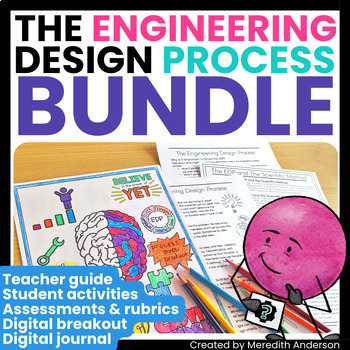Engineering Design Process Guide, Activities, Journal, Rubrics, Breakout BUNDLE
- Zip
- Google Apps™
- Internet Activities

What educators are saying
Products in this Bundle (5)
Description
This download contains a bundle of resources focused on the engineering design process!
Get started with the EDP, then try a digital breakout (2 options included - one for elementary and one for upper grades)! I have also included a digital STEM journal for students to record their process (plus a printable option).
✅ What You'll Get ✅
Engineering Design Process Worksheets, Activities, Rubrics, and More:
This resource is the culmination of years of my work as an engineer and STEM educator! In it, you will find:
- ✅ A 20+ page teacher guide:
- A brief overview of STEM and why it's important
- An in-depth look at each step of the EDP
- The 4 Cs and STEM
- The Scientific Method and comparison to the EDP
- A simplified and fun acronym option for teaching the EDP to younger students
- How to tell if it's STEM (Is it Impostor STEM or ✨ Authentic ✨ STEM?)
- Video links to introduce the EDP
- STEM challenge tips
- Walk-through for Index Card STEM challenge
- Completed samples
- Follow-up questions to ask students to assess STEM learning and encourage out-of-the-box thinking
- ✅ Student Printables
- 3-page introduction to the EDP
- EDP warm up activity (2 levels provided)
- Research an engineering profession
- EDP printable (students label and define steps)
- Scientific method overview and EDP comparison (3 pages)
- EDP and Scientific Method sorting activity
- EDP knowledge check/assessment (2 options)
- Growth mindset and failure color and doodle page (2 options)
- ✅ Bonuses
- Checklists and Rubrics: 6 pre-made checklists and rubrics plus 3 editable options (in Google Slides)
- EDP Posters: Choose from "Ask Imagine Plan Create Improve" or DIP ME "Define Imagine Plan Make Enhance" (If you attended Elementary STEM Con, you may remember Dip Me!)
- Graphic Organizers and STEM Challenge Recording Sheet: Several options to choose from for students to record their ideas, data, and progress.
- Spot Impostor STEM! Can you tell the difference between a high-quality, authentic STEM challenge and an impostor? Use the graphic and checklist to vet STEM challenges you want to try in your classroom.
STEM Journal
Instructions on using the resource, with examples (10 pages): Also includes instructions for using with Microsoft OneDrive.
- Digital Interactive Journal / Notebook (8 pages each): Cover page, main menu navigation page, and pages for each of the steps in the engineering design process:
- Ask
- Imagine
- Plan
- Create
- Improve
- Reflect
What I love about going digital for STEM journals is that so much can be shown in photographs, and adding digital photographs to the journal really helps illustrate the process. It also makes it easier for kids to part with their creations if necessary, because they can refer back to the picture at any time. Traditional STEM journals and recording pages tend to miss out on this, especially if the model created is tested to failure or if it's too large to keep.
EDP Digital Breakout (Please note both versions are included)
Do you want to introduce or review the engineering design process in an engaging and fun way? This digital breakout activity, similar to an escape room but without the need for physical locks, does just that! Students do not need any prior knowledge about engineering or the EDP to do this breakout, though it can be used as a review. In this resource, students will:
- Learn about the engineering design process (5 slides of informational text)
- Solve 6 digital puzzles related to the EDP (a variety of puzzle types are included, from image puzzles, to ciphers, to demonstrating learned knowledge)
- Use technology skills to complete the activities (entering text into Google Slides, Google Forms, rotating objects, clicking and dragging objects).
- Use creative problem solving skills to decode the puzzles.
- Complete follow-up activities to demonstrate subject mastery (printable, optional).
What You'll Get
- Teacher instructions on how to use this resource, tips for success, and completed samples of every puzzle.
- 5 slides of informational text about simple machines (inclined planes, levers, pulleys, screws, wedges, and wheels/axles).
- 6 slides of digital breakout puzzles
- Follow up assessment/activity (multiple options provided for scaffolding).
For this activity, you will need access to Google Classroom (or Google Slides and Google Forms, for use at home), internet access, and devices to complete the activity (laptops or Chromebooks are recommended).





